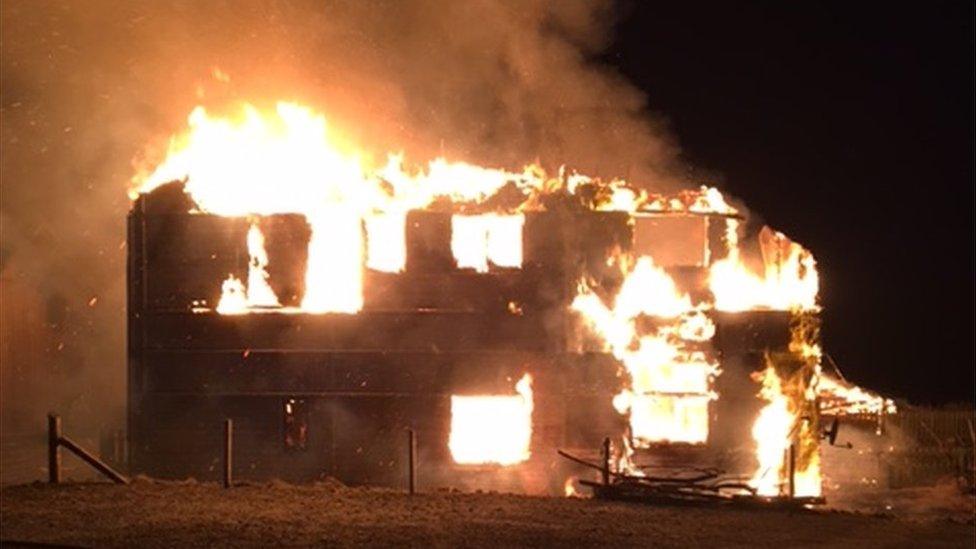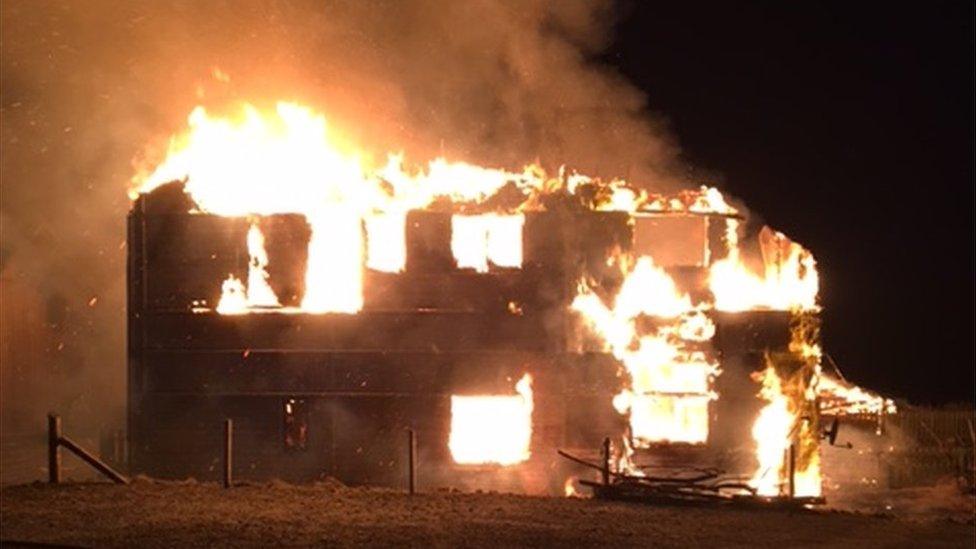Shetland fires 'should act as warning to modular building industry'
- Published
The Moorfield Hotel has been extensively damaged by the fire
Two devastating fires in Shetland should act as a warning to the modular building industry, it has been claimed.
The world-famous Fair Isle Bird Observatory was lost in 2019, followed last year by the Moorfield Hotel.
Both buildings were less than 10 years old and made from factory-built units, which had been shipped up to Shetland by sea.
One expert has called for a full investigation into why the fires took hold so quickly.
Both blazes were particularly severe, and fire crews were unable to stop the spread. No-one was injured in either incident.
The observatory had no guests when it was destroyed in March 2019. Susannah and David Parnaby, who were its warden and administrator at the time, had been out when the fire started.
The wing of the observatory housing the flat where they lived for a decade was the last section to burn.
"I stayed until it was dark," Mrs Parnaby said. "Where our flat was, that was the last wall to completely burn. I stayed till that point - you know, you've got to see it out, got to witness it, in a weird way."
The couple, who have two children, were made redundant earlier this year but have managed to stay on the island as crofters.
The Moorfield Hotel had 70 occupants on the night it caught fire in July 2020. It was due to close a week later having lost its contract to house gas plant workers.

Susannah and David Parnaby lost their home in the fire
A Scottish Fire and Rescue Service (SFRS) investigation into the Fair Isle blaze was inconclusive, stating that the blaze was likely to have started in the roof space.
The SFRS is still investigating the Moorfield Hotel fire, but police said their inquiry was finished, having found no suspicious circumstances.
Modular construction is currently enjoying a boom. It is seen as cost-effective, quick and greener; the UK government wants 25% of new affordable homes to be modular.
However, some experts are worried that there is also a fire risk and are pointing to the Shetland fires as a warning.
Prefab has been around for some time, but stacking modules on top of each other is causing Ian Abley, a technical designer who works for the Fire Protection Association, some concern.

Ian Abley said fire getting into the cavities between modules was a problem
He writes guidance for insurers about modular buildings and has used one of the Shetland fires as an example in his latest report.
"For the Moorfield Hotel, it's a problem of the fire getting into the cavity between the modules," he explained.
"If it can travel from one compartment to another through unseen spaces within the compartment walls and floors, there's very little the fire brigade can do.
"If you're not very careful in the way you put it together there may be combustible materials in those cavities."
Both the hotel and the observatory had passed building standards approval.
However, documents obtained via Freedom of Information show a case officer raised concerns about fire safety in the design stage of the Moorfield Hotel.
BBC Scotland tracked down the man who made the notes.

Stewart Douglas had been concerned at the possibility of fire spreading
Stewart Douglas, who is now retired from Shetland Islands Council, identified his handwriting on the plans, and explained he had been concerned at the possibility of fire spreading from a bathroom into a service void.
It was not the only issue he had with the design, but these must have been addressed, he said, or the building plans would not have been approved by the council.
However, Mr Douglas, who worked in the industry for more than four decades, said sometimes in the construction trade the plans that are signed off do not always match what is built.
Asked if the Moorfield Hotel plans matched what was built, he said he could not be 100% sure.
"The only way I could be sure about that is if I'd been on site on a very regular basis, if not daily," he said.
"It's not the building standards officer's role or duty to ensure that work's done properly. It's the building owner's responsibility."

Fair Isle Bird Observatory (pictured in the background) was built in 2010
Architect Malcolm Fraser also watched the Shetland fires closely. He works with Construction Scotland Innovation Centre on delivering timber modular buildings, such as the Fair Isle observatory.
"What an extraordinary piece of terrible luck that both the Moorfield and the observatory, as representing the new ways of building on the islands, have both gone on fire", he said.
He believes the investigations should be more wide-ranging, looking at the design of both buildings.
"Were there firebreaks? Did the firebreaks work? Were they installed correctly? And if so, why did the fire seem to have leapt past them?
"These are the obvious questions.
"If this is really the 'construction technology of the future' we need to find out why the fires took hold so quickly. We need the full investigations," he said.

Fair Isle Bird Observatory was destroyed by fire in 2019
McAleer and Rushe, the contractor which built the Moorfield Hotel, denied any suggestion that there were issues with the construction quality.
It said: "Following the fire at Moorfield Hotel we provided the fire authority with all relevant documentation, including compliance certificates relating to the project, which was completed in 2013. Certificates supplied were compliant with regulations."
BDL Hotels, former owners of the Moorfield Hotel, said they welcomed any review of fire and life safety measures.
"The Moorfield Hotel was designed and built to ensure the safety of guests and staff at all times," a statement said.
"The hotel was built by a specialist hotel contractor to all relevant standards, approved by building control and independently inspected by the professional team during construction and at completion.

"The fire started on the top floor, and the fire spread externally along the flat roof behind the false pitched roof. The fire's location made it extremely difficult to reach without the use of aerial firefighting equipment.
"It is sad that despite the heroic efforts of the firefighters the building could not be saved."
Andrew H Wilson Electrical, the builder of the Fair Isle Bird Observatory, went into receivership in 2010.
Fair Isle Bird Observatory Trust, the owners of the observatory, declined to comment.
Fire safety expert Mr Abley wants assurances in the industry.
He said: "If the construction industry doesn't know how to do cavity construction that prevents fire from spreading from one floor to another, it needs to learn and fast."
Related topics
- Published27 July 2020

- Published11 March 2019
